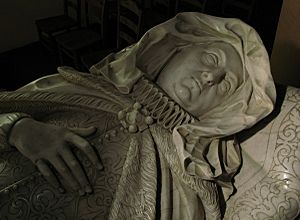Elizabeth Danvers facts for kids
Quick facts for kids
Elizabeth Neville
|
|
|---|---|

Monument to Elizabeth Neville in St Michael's Church, Stowe, Northamptonshire
|
|
| Born | c.1545 |
| Died | 1630 |
| Noble family | House of Neville |
| Spouse(s) | Sir John Danvers |
| Issue | Sir Charles Danvers Henry Danvers, 1st Earl of Danby Sir John Danvers Lucy Danvers Elizabeth Danvers Eleanor Danvers Anne Danvers Catherine Danvers Mary Danvers Dorothy Danvers |
| Father | John Neville, 4th Baron Latimer |
| Mother | Lucy Somerset |
Lady Elizabeth Danvers (born Neville), later known as Lady Elizabeth Carey after remarrying, was an important English noblewoman who lived from about 1545 to 1630. She was the mother of two famous sons. Her son, Sir Charles Danvers, faced serious consequences in 1601 for his involvement in a rebellion. Another son, Sir John Danvers, played a role in the trial of King Charles I.
Contents
Elizabeth's Family Background
Elizabeth Neville was born between 1545 and 1550. She was the youngest daughter of John Nevill, 4th Baron Latimer, and Lucy Somerset. Her mother, Lucy, was the daughter of Henry Somerset, 2nd Earl of Worcester.
Elizabeth had three older sisters:
- Katherine Neville (born 1545/6 – died 1596), who married Henry Percy, 8th Earl of Northumberland.
- Dorothy Neville (born 1548 – died 1609), who married Thomas Cecil, 1st Earl of Exeter. He was the eldest son of Lord Burghley, a very important advisor to Queen Elizabeth I.
- Lucy Neville (born c.1549 – died 1608), who married Sir William Cornwallis.
Life and Marriages
Elizabeth Neville was known for being very smart and capable. A writer named John Aubrey, who was related to her, described her as having "prodigious parts for a Woman." This meant she had amazing talents. He said she knew Chaucer's writings very well. She was also described as a "great Politician" and someone with a "great Witt and spirit." She was good at managing her money and understood jewels. She was also very beautiful, though she was short-sighted.
Elizabeth first married Sir John Danvers (1540–1594). He was from Dauntsey, Wiltshire. Together, they had three sons and seven daughters.
Their children included:
- Sir Charles Danvers (c.1568–1601).
- Sir Henry Danvers (1573–1644).
- Sir John Danvers (1588–1655).
- Lucy Danvers (1572–1621).
- Elizabeth Danvers.
- Eleanor Danvers (died 1601).
- Anne Danvers.
- Katherine Danvers.
- Mary Danvers.
- Dorothy Danvers (1590–1650).
A Family Challenge
In 1594, a difficult event happened involving Elizabeth's sons. Her second son, Henry Danvers, was involved in a serious incident where Henry Long was killed during a local disagreement. Elizabeth's husband, Sir John Danvers, had been dealing with problems caused by Sir Walter Long's servants. This led to tensions between the Danvers and Long families.
During a confrontation, Henry Long was fatally injured. The Danvers brothers, Charles and Henry, had to leave the country to avoid arrest. They found safety at the court of King Henri IV in France.
This difficult situation may have affected Sir John Danvers, who passed away two months later in December 1594. He was buried in Dauntsey church.
Remarriage and Pardons
In 1598, the widowed Lady Danvers married Sir Edmund Carey (c.1557–1637). He was a cousin of Queen Elizabeth I. Many believed she married him to help her sons get pardons. Her efforts, along with others, worked. In June 1598, Queen Elizabeth pardoned both Danvers brothers. They had to pay Sir Walter Long £1500 as compensation for the incident.
However, in February 1601, Sir Charles Danvers became involved in Essex' short-lived rebellion. He was found guilty of treason. Despite offering a large sum of money, he was executed in March 1601.
After this, Sir Henry Danvers continued to serve in the English army in Ireland. In 1603, King James I made him Baron Danvers of Dauntsey because of his brave service.
Lady Carey's third son, Sir John Danvers, later played a significant role in the events of the First English Civil War, specifically concerning King Charles I.
Later Life and Legacy
Lady Carey passed away in 1630 at the age of 84. She was buried in St. Michael’s Church in Church Stowe in Stowe Nine Churches, Northamptonshire. Her monument, created by the famous sculptor Nicholas Stone, is considered a beautiful piece of art from that time. It was actually installed around 1620, while she was still alive.

